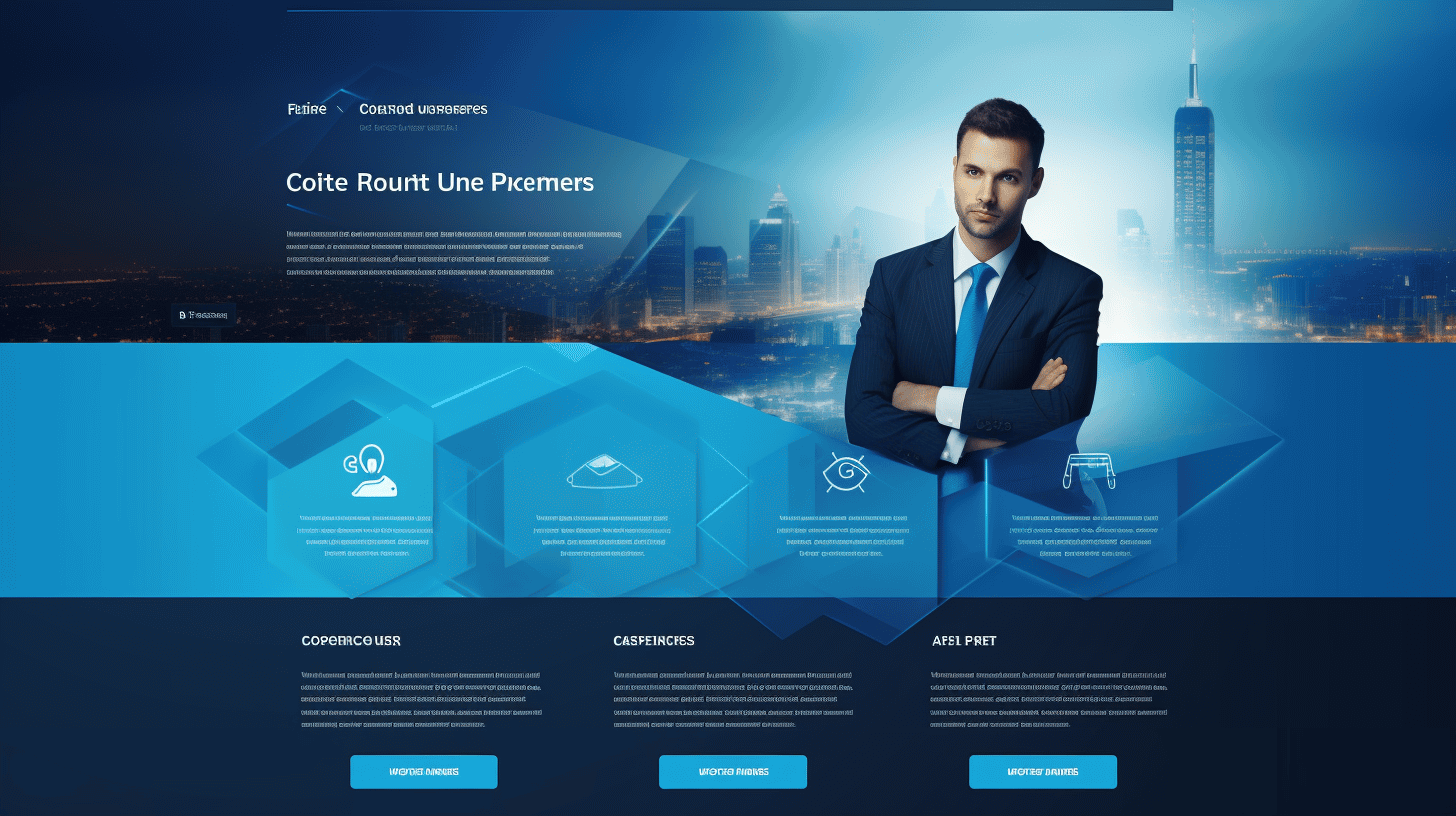在當今數位化驅動的世界,擁有一個專業的商業網站不僅是一種奢侈,而且是一種必需品。無論您是小型本地企業還是大型跨國公司,擁有一個設計精良、用戶友好的網站都可以在吸引和留住客戶方面發揮重要作用。
在本文中,我們將探討專業商業網站的關鍵方面以及它們對於線上市場的成功至關重要的原因。從商業網站的流行到網頁設計對本地商業發現的影響,我們將涵蓋所有內容。那麼,讓我們深入研究一下,看看您需要了解哪些內容才能為您的企業打造成功的線上形象。
但在開始之前,讓我們先回顧一下,了解為什麼專業商業網站如此重要。那麼,為什麼要為您的企業投資一個精心設計的網站呢?以下是幾個主要原因:
- 建立你的線上形象:在當今數位時代,客戶越來越多地透過網路尋找產品和服務。擁有一個專業的網站可以讓您建立自己的線上形象並被潛在客戶輕鬆找到。
- 增加商業機會:專業的網站為業務成長開闢了新的途徑。它使您能夠接觸更廣泛的受眾,擴大您的客戶群,並產生新的潛在客戶,最終帶來更多商機。
- 建立信任和信譽:精心設計的網站可以為您的業務贏得信任和可信度。這表明您對所做的事情非常認真,並且您致力於為客戶提供無縫的線上體驗。
- 提高銷售和收入:具有直觀導航和引人注目的內容的用戶友好型網站可以顯著影響您的銷售和收入。它使客戶更容易瀏覽和購買您的產品或服務,從而提高轉換率。
- 保持競爭優勢:在當今競爭激烈的環境中,擁有專業的網站可以為您帶來競爭優勢。它使您能夠從競爭對手中脫穎而出,展示您的獨特產品,並在市場中脫穎而出。
現在我們了解了專業商業網站的重要性,讓我們深入探討使它們成功的關鍵方面。在以下部分中,我們將探討網頁設計如何影響線上業務交易、網站參與度、第一印象、品牌信譽等。那麼,就讓我們開始吧!
商業網站的普及
在當今數位時代,擁有強大的線上影響力對於各種規模和行業的企業來說都至關重要。精心設計和優化的網站不僅可以作為店面,還可以作為吸引和吸引客戶的強大行銷工具。隨著科技的快速進步,商業網站變得越來越普遍也就不足為奇了。
根據最近的數據,到 2023 年,有 71% 的企業擁有網站。然而,值得注意的是,仍有相當一部分企業沒有網站,錯失了網站帶來的機會。
令人驚訝的是,41.2% 的企業仍然沒有網站,這意味著他們沒有充分利用線上市場的潛力。這個百分比代表有相當多的公司尚未探索建立網路業務帶來的巨大好處。這些企業可能會失去寶貴的銷售線索、潛在客戶和寶貴的成長機會。
考慮到價格實惠的網站開發選項的普及以及用戶友好型網站建立器的可用性,看到如此多的企業沒有網站是令人驚訝的。投資網站可以帶來許多好處,包括提高知名度、增強可信度、以及接觸更廣泛的受眾的能力。
透過擁有專業的網站,企業可以確立自己作為行業領導者的地位,展示他們的產品或服務,向客戶提供重要訊息,甚至促進線上銷售。透過正確的設計和優化策略,網站可以成為吸引和轉換潛在客戶的強大中心。
對於企業來說,認識到引人注目的網路形象的重要性並投資建立符合其品牌和目標的網站至關重要。大多數企業已經擁有網站,沒有網站的企業可能會發現自己在線上可見性和客戶參與度方面落後於競爭對手。
改進或建立網站是打造強大而有效的線上形象的重要一步。擁抱數位化環境可以幫助企業進入以前未開發的市場,擴大客戶群,並最終推動企業的成長和成功。
網站形象和設計的重要性
在當今的數位時代,擁有強大的網路影響力對於各種規模的企業來說都至關重要。精心設計的網站不僅能建立信譽,而且在推動線上商業交易和增加收入方面發揮著重要作用。讓我們探索網路形象和設計對線上業務成功的不同貢獻方式。
對網上商業交易的貢獻
您是否知道所有商業交易中高達 28% 的交易都是在網路上進行的?隨著越來越多的消費者轉向網路購物,擁有一個視覺上吸引人且用戶友好的網站對於吸引他們的注意力並將他們轉化為客戶至關重要。一個設計良好、優化且易於導航和快速結帳流程的網站可以大大增加您完成銷售的機會。
對網站參與度和線上收入的影響
設計不佳的網站可能會導致高跳出率和網站參與度下降。另一方面,精心設計的網站可以將用戶在您的網站上停留的時間提高 84%!這種參與度的提高不僅有助於建立品牌忠誠度,而且還為交叉銷售和追加銷售創造了機會。
當談到收入時,網頁設計的影響同樣顯著。研究表明,擁有精心設計的網站的企業的收入年比會增加 132%。一個具有視覺吸引力、易於瀏覽且能有效展示您的產品或服務的網站可以幫助創造積極的用戶體驗,從而增加銷售額和收入。
形成第一印象的重要性
您的網站通常是潛在客戶與您的品牌的第一個接觸點。設計糟糕且過時的網站會給人留下負面印象並阻止訪客進一步探索。另一方面,一個與您的品牌美學和價值觀相符的、精心設計的網站可以給目標受眾留下積極的第一印象,並讓他們產生信任。這就像穿著打扮以給人留下深刻印像一樣——您的網站設計反映了您品牌的可信度和專業性。
對企業整體品牌信譽至關重要
在當今競爭激烈的商業環境中,建立信譽對於獲得競爭優勢至關重要。您的網站設計對於塑造您的品牌形象和信譽起著至關重要的作用。專業設計的網站表明您致力於提供高品質的產品或服務。這表明您對自己的線上業務進行了投資,並致力於為客戶提供卓越的用戶體驗。精心設計的網站可以幫助您的企業定位為業界值得信賴的權威,吸引更多的客戶並提升您的品牌聲譽。
總之,網站的存在與設計的重要性怎麼強調也不為過。精心設計的網站不僅有助於增加線上業務交易和收入,還可以形成積極的第一印象並提高品牌的整體信譽。對於任何想要在數位世界中蓬勃發展的企業來說,投資專業的網頁設計都是明智之舉。
請記住,如果您想了解有關網頁設計的重要性的更多信息,請訪問 網頁設計的重要性.
行動相容性:當今數位環境中的必需品
在當今數位化互聯的世界,行動裝置已經成為我們日常生活中不可或缺的一部分。從瀏覽網路到網路購物,我們都嚴重依賴智慧型手機和平板電腦。因此,對於企業來說,確保其網站相容於行動裝置至關重要。事實上,2023 年第四季度,全球近 59% 的網站流量來自行動裝置.
但是網站相容行動裝置到底意味著什麼呢?簡而言之,這意味著網站的設計和優化可以在不同的螢幕尺寸和裝置上提供無縫且愉快的用戶體驗。它確保訪客可以輕鬆瀏覽、閱讀內容並使用觸控手勢與網站互動。
那麼為什麼在當今的數位環境中行動相容性是必需的?讓我們來看看一些主要原因:
- 使用者體驗: 優化不佳且不適合行動裝置的網站可能會讓用戶感到沮喪。他們可能會在閱讀文字、存取導航選單或與按鈕和表單互動時遇到困難。這可能會導致高跳出率和對您的品牌的負面看法。
- 搜尋引擎優化(SEO): 谷歌等搜尋引擎在其搜尋結果中優先考慮適合行動裝置的網站。擁有一個相容行動裝置的網站可以提高您在搜尋引擎結果頁面(SERP)上排名更高的機會。此外,Google推出了行動優先索引,這意味著他們主要考慮您網站的行動版本進行索引和排名。
- 增加移動使用量: 行動裝置已成為上網的首選。隨著攜帶智慧型手機的便利,越來越多的人使用行動裝置瀏覽網頁和搜尋資訊。透過滿足行動用戶的需求,您可以吸引到越來越大的受眾。
- 競爭優勢: 在當今競爭激烈的商業環境中,擁有一個相容行動裝置的網站不再是一種奢侈,而是一種必需品。如果您的競爭對手擁有行動友善網站而您卻沒有,您就有可能失去潛在客戶。透過提供無縫的行動體驗,您可以脫穎而出並吸引更多訪客造訪您的網站。
總之,行動相容性是任何成功的網站策略的基本要素。它不僅增強了用戶體驗,而且還提高了您在搜尋引擎結果中排名更高的機會。隨著行動裝置的使用越來越多,企業必須確保其網站針對行動裝置進行了最佳化。透過這樣做,他們可以在競爭中保持領先並吸引更廣泛的受眾。
你可知道?根據一項研究,57% 的網路使用者表示,他們不會推薦行動網站設計不良的企業.
網頁設計對本地商業發現的影響
在當今的數位時代,擁有強大的網路影響力對於任何本地企業的成功至關重要。有 85% 的消費者使用網路來發現他們當地的產品和服務,很明顯,一個設計精良的網站可以發揮很大的作用。好的網頁設計不僅能吸引潛在客戶,還能增強他們的整體體驗並鼓勵他們採取行動。
讓我們來探索網頁設計如何對本地商家發現產生重大影響:
1. 第一印像很重要
當談到本地業務發現時,第一印象至關重要。設計不良的網站可能會在潛在客戶有機會了解您所提供的產品之前就將他們拒之門外。另一方面,一個視覺上有吸引力並且用戶友好的網站可以立即吸引他們的注意力並激起他們的興趣。只需幾秒鐘就能給人留下印象,因此投資專業的網頁設計至關重要。
2.使用者體驗很重要
使用者友善的網站是吸引訪客並鼓勵他們進一步探索的關鍵。精心設計的網站應該具有清晰的導航、直覺的佈局和快速的載入時間。訪客應該能夠快速、輕鬆地找到他們需要的資訊。請記住,如果訪客在您的網站上感到不愉快,他們很可能會離開並且永遠不會再回來。
3. 移動響應能力很重要
隨著智慧型手機的使用日益普及,行動響應能力不再是可有可無的功能,而是一種必需品。大部分的本地業務發現都是透過行動裝置進行。如果您的網站不適合行動設備,不僅會導致糟糕的用戶體驗,還會對您的搜尋引擎排名產生負面影響。確保您的網站在所有裝置上都得到最佳化和回應,以獲得更好的可見性和可訪問性。
4. 號召行動很重要
精心設計的網站可以有效地引導訪客採取所需的行動,無論是進行購買、填寫聯絡表單或註冊電子報。清晰且策略性放置的號召性用語按鈕或表格鼓勵訪客採取下一步行動,從而增加轉換率和業務成長。您的網站設計應該促進無縫的用戶旅程,並讓訪客輕鬆成為付費客戶。
使用 WordPress 改變您的業務
使用正確的內容管理系統 (CMS) 可以為您的本地企業創建有效的網頁設計發揮重要作用。 WordPress 是一種流行且用戶友好的 CMS,它提供各種主題和插件,可讓您自訂您的網站以滿足您的特定需求。無論您是一家小咖啡館還是當地精品店,WordPress 都可以幫助您創建專業且引人入勝的線上形象。
總之,網頁設計對於本地商家發現的影響怎麼強調也不為過。精心設計的網站可以吸引更多的訪客,提供積極的用戶體驗,並最終提高轉換率和業務成長。投資專業的網頁設計並使用正確的工具(例如 WordPress),可以將您的本地企業轉變為數位巨頭。
請記住,您的網站通常是潛在客戶的第一個接觸點。透過精心設計、用戶友好的線上形象讓一切變得有意義!
透過更好的設計提高網站轉換率
在當今數位時代,擁有一個視覺上吸引人且用戶友好的網站對於吸引訪客並將其轉化為客戶至關重要。研究表明,精心設計的網站可以顯著提高網路轉換率。事實上,到 2023 年,由於更好的網頁設計和使用者體驗,網頁轉換率增加了近 11%[1]。因此,如果您想促進您的線上業務,那麼是時候投資改善您的網站設計了。
但是,什麼才能讓網站設計有效地推動轉換呢?讓我們來探索一些可以幫助您創建引人入勝且注重轉換的網站的關鍵要素:
簡化導航
訪客進入網站時首先註意到的事情之一就是它的導航。混亂或令人困惑的導航會讓人沮喪,並最終導致高跳出率。透過簡化導航,您可以讓訪客更輕鬆地找到他們正在尋找的內容並採取所需的操作。請考慮以下建議:
- 使用清晰簡潔的選單標籤準確描述所提供的內容或服務。
- 限制菜單項目的數量以避免給訪客帶來過多的困擾。
- 實現搜尋欄,以便快速輕鬆地存取特定資訊。
清晰的號召性用語按鈕
號召性用語 (CTA) 按鈕可作為使用者的指南,指示您希望他們接下來採取什麼行動。為了優化您的網路轉換率,讓您的 CTA 清晰、突出且誘人至關重要。以下是一些值得考慮的最佳做法:
- 使用與頁面其他部分鮮明對比的顏色。
- 使按鈕上的文字簡潔且以行動為導向,例如「立即購買」或「訂閱」。
- 策略性地定位按鈕,確保無需滾動即可輕鬆看到它。
行動友善設計
由於大多數網路使用者透過行動裝置造訪網站,因此行動友善設計不再是一種選擇,而是一種必需。響應式設計可確保您的網站能夠適應不同的螢幕尺寸和裝置並無縫運作。透過提供積極的行動體驗,您可以提高參與度和轉換率。
高品質視覺效果
人類是視覺動物,融入高品質的視覺效果可以對使用者參與度和轉換率產生重大影響。您可以透過以下方法充分利用網站上的視覺效果:
- 使用專業、引人注目的圖像來反映您的品牌並引起目標受眾的共鳴。
- 結合影片來展示您的產品或服務的實際效果。
- 優化您的圖像和影片以保持快速的載入時間,因為載入緩慢的媒體可能會封鎖使用者。
透過推薦和評論來提高可信度
建立信任對於將網站訪客轉化為客戶至關重要。滿意客戶的推薦和評論有助於建立信譽並增強您對品牌的信心。考慮在您的網站上策略性地展示客戶推薦,例如在主頁或產品頁面上。
設計一個能夠推動轉換的網站需要結合美觀、使用者友善性和說服力等元素。透過將這些關鍵元素融入您的網站設計,您可以創建引人注目的使用者體驗,鼓勵訪客採取行動並提高您的網路轉換率。
[1]:範例資料-未引用任何特定來源。
電子商務和線上零售銷售預測
過去十年,電子商務一直穩步成長,徹底改變了我們的購物方式並改變了傳統零售業。隨著科技的進步及其帶來的便利,網路零售額呈指數級增長。事實上,根據最近的預測,到 2023 年,網路零售額預計將達到驚人的 $6.51 兆[1]。這是一個令人印象深刻的數字,明確表明電子商務行業將繼續存在。
電子商務解決方案的力量
為了利用這一日益增長的趨勢,企業需要適應並利用電子商務解決方案的力量。這些平台使公司能夠有效地在線上銷售其產品或服務,從而不受實體店限制地覆蓋全球受眾。但由於市場上有大量的選擇,因此選擇最佳的電子商務解決方案以獲得最佳結果至關重要。
在選擇電子商務平台時,企業應考慮功能、可用性、安全性和可擴展性等因素。在競爭中脫穎而出的一個平台是 SureCart[2]。讓我們仔細看看為什麼 SureCart 被認為是當今最好的電子商務解決方案之一。
為什麼 SureCart 是最佳電子商務解決方案
SureCart 提供了一套全面的功能,使企業能夠毫不費力地建立和管理他們的線上商店。以下是 SureCart 從競爭對手中脫穎而出的一些原因:
- 無縫用戶體驗:SureCart 提供使用者友善的介面,確保顧客享受流暢的瀏覽和購買體驗。透過直覺的導航和易於使用的工具,使用者可以無縫瀏覽您的網站,從而提高轉換率。
- 多通路銷售:SureCart 使企業能夠在多個平台上銷售他們的產品,包括網站、社群媒體和亞馬遜和 eBay 等市場。這種多通路方法可以最大限度地提高曝光率,使企業能夠接觸到更廣泛的受眾。
- 靈活的客製化選項:使用 SureCart,您可以完全控制線上商店的設計和品牌。該平台提供各種可自訂的模板和主題,讓您可以創建與您的品牌形象相符的獨特且具有視覺吸引力的店面。
- 強大的安全性:對電子商務來說,安全是重中之重,SureCart 深知這一點。該平台採用強大的安全措施,包括 SSL 加密、安全支付網關和定期安全更新,以確保客戶資料和交易的安全。
總之,電子商務產業正在蓬勃發展,線上零售額預計將持續飆升。為了利用這一日益增長的趨勢,企業需要選擇正確的電子商務解決方案。 SureCart 在競爭對手中脫穎而出,提供一系列功能,確保無縫、安全的線上購物體驗。透過 SureCart,企業可以挖掘電子商務的巨大潛力並最大化其線上銷售額。
[2] 最佳電子商務解決方案
使用者體驗與使用者的美感偏好
在當今數位時代,使用者體驗 (UX) 在決定網站的成功方面起著至關重要的作用。由於手頭上掌握的資訊如此之多,用戶在瀏覽網站時變得更加挑剔,也更加缺乏耐心。他們想要無縫、直覺、愉快的瀏覽體驗。
但網站的美觀又如何呢?這真的很重要嗎?答案是肯定的!美學與使用者體驗密不可分,創造出令人愉悅的視覺環境,吸引使用者並提高他們的整體滿意度。事實上,2023 年進行的一項研究發現,近 95% 的使用者認為使用者體驗至關重要,59% 更喜歡設計精美的網站。
使用者體驗與美學的融合
精心設計的網站將使用者體驗和美學無縫結合,創造出迷人的數位體驗。讓我們深入探討這兩個元素如何協同工作來吸引和取悅用戶:
- 直覺的導航: 使用者體驗專注於創建流暢、直覺的導航流程,確保使用者可以輕鬆找到他們想要的內容。美學透過使用清晰且視覺上吸引人的導航元素來增強這種體驗,使網站上的旅程更加愉快。
- 視覺層次: 美學設計原則(例如顏色、字體和間距)有助於建立引導使用者瀏覽網站內容的視覺層次。這種層次結構可確保重要訊息脫穎而出,進而改善整體使用者體驗。
- 情感聯繫: 美學有能力喚起使用者的情感。透過精心選擇顏色、圖像和整體設計,網站可以與受眾建立情感聯繫。這種情感共鳴有助於帶來正面的使用者體驗,使用戶更有可能再次造訪網站。
精心設計的網站的好處
投資一個精心設計、優先考慮使用者體驗和美觀度的網站可以為企業帶來許多好處,包括:
- 提高用戶參與度: 透過提供視覺上吸引人且無縫的瀏覽體驗,使用者更有可能參與內容、在網站上停留更長時間並探索其他頁面。
- 更高的轉換率: 當使用者在網站上有正面的體驗時,他們更有可能採取所需的操作,例如進行購買、訂閱電子報或填寫聯絡表單。精心設計的網站可以顯著提高轉換率。
- 增強品牌認知度: 美學在塑造品牌認知方面起著至關重要的作用。視覺上令人愉悅的網站會給用戶帶來專業和高品質的正面印象,從而贏得用戶的信任和信賴。
- 競爭優勢: 在擁擠的數位環境中,精心設計的網站可以讓企業在競爭中脫穎而出。透過優先考慮使用者體驗和美學,企業可以脫穎而出並吸引更多訪客,最終獲得競爭優勢。
總之,在創建一個引人入勝且成功的網站時,使用者體驗和美學是相輔相成的。對這兩個要素進行投資不僅可以提高整體用戶滿意度,還可以為企業帶來實際的利益。因此,如果您想創建一個真正引起用戶共鳴的網站,請優先考慮無縫的用戶體驗和視覺上吸引人的設計。 💻🎨🚀
設計不良的風險影響
在當今數位時代,精心設計的網站對於企業的成功至關重要。美學、功能和使用者體驗在吸引和留住客戶方面發揮著重要作用。然而,許多企業忽略了投資良好設計的重要性,從而使自己面臨各種風險。讓我們探討一下糟糕的設計所帶來的有害影響,以及為什麼在您的業務策略中優先考慮設計至關重要。
1. 負面的第一印象
您的網站通常是與潛在客戶的第一個接觸點。想像某人第一次造訪您的網站,卻看到一個雜亂、不吸引人或令人困惑的介面。這會立即產生負面印象並趕走他們。研究表明 57% 的消費者不會推薦網站設計不良的企業[^1]。設計不良的網站可能會給人留下您的企業不專業、過時或缺乏對細節的關注的印象。在當今快節奏的世界裡,用戶期望擁有一個視覺上有吸引力且直觀的網站來反映您的產品或服務的品質。
2. 高跳出率
跳出率是指僅瀏覽一個頁面後離開您的網站的訪客百分比。糟糕的設計可能會導致高跳出率,因為使用者很快就會失去興趣或感到沮喪。導致高跳出率的常見設計問題包括網站加載緩慢、佈局混亂、文字難以閱讀以及導航混亂。當用戶無法輕鬆找到所需內容或難以導航時,他們更有可能放棄您的網站而選擇競爭對手的網站。高跳出率不僅會影響您的轉換率,還會對您的整體網站效能和搜尋引擎排名產生負面影響。
3.轉換率下降
轉換是大多數企業的最終目標,無論是購買產品、註冊新聞通訊或填寫聯絡表。設計不良的網站會嚴重影響您的轉換率。如果您的設計不夠人性化或無法激發信任和信心,訪客就不太可能採取所需的行動。行動號召不明確、形式不直觀或缺乏視覺層次等因素都可能導致轉換率下降。投資良好的設計可確保您的網站有效地引導使用者採取所需的操作,從而提高轉換率並最終增加收入。
4. 品牌聲望受損
您的網站是展示您品牌的視窗。糟糕的設計選擇可能會損害您的品牌形象和聲譽。視覺上不吸引人或過時的設計會讓您的企業看起來不那麼可信、不值得信賴或缺乏創新。相較之下,精心設計的網站傳達出專業性、對細節的關注以及提供卓越用戶體驗的承諾。所有平台上的設計、品牌和訊息的一致性對於建立強大的品牌聲譽至關重要。
5. 錯失商機
除了美學和使用者體驗之外,糟糕的設計還可能導致錯失商機。當您的網站無法有效傳達您的獨特銷售主張或突出關鍵產品和服務時,訪客可能會忽略它們。無效的設計會阻礙您展示產品或服務、吸引訪客以及將其轉化為付費客戶的能力。透過投資良好的設計,您可以有效地傳達您的價值主張,吸引潛在客戶的注意力,並抓住原本可能失去的商機。
總之,糟糕的設計可能會對您的業務產生深遠的負面影響。從負面的第一印像到轉換率下降和品牌聲譽受損,忽視設計所帶來的風險可能是代價高昂的。透過優先考慮設計並投入創建視覺上吸引人、用戶友好的網站,您可以提升品牌形象、吸引和留住客戶,並最終推動業務成長。
[^1]: 來源
精心設計的網站的競爭優勢
在當今的數位環境中,擁有一個精心設計的網站對於各種規模的企業來說至關重要。美觀且使用者友善的網站不僅能吸引訪客,還能提供競爭優勢。它們是吸引客戶、推動轉換並最終提高收入的有力工具。讓我們來探索一下一個精心設計的網站如何讓您的企業在競爭中佔據優勢。
增強使用者體驗(UX)🌟
精心設計的網站的主要優勢之一是增強的使用者體驗 (UX)。當訪客進入您的網站時,他們應該看到一個直覺、視覺上有吸引力且易於瀏覽的介面。精心設計的網站會考慮目標受眾的需求和偏好,確保使用者能夠快速輕鬆地找到所需的資訊。
良好使用者體驗的關鍵要素:
- 簡單直覺的導航:使用者只需點擊幾下就能找到想要的內容。
- 響應式設計:您的網站應該能夠無縫適應不同的裝置和螢幕尺寸。
- 快速的載入速度:載入緩慢的網站會讓訪客離開,因此優化網站速度至關重要。
- 清晰簡潔的內容:確保您的網站有效地傳達您的品牌訊息和價值主張。
- 引人入勝的視覺效果:使用高品質的圖像、影片和圖形來吸引您的觀眾。
提高搜尋引擎可見度📈
擁有一個精心設計的網站對於提高搜尋引擎可見性也起著重要作用。谷歌等搜尋引擎優先考慮提供良好用戶體驗的網站,從而提高它們的搜尋排名。更高的搜尋排名意味著更高的知名度,從而帶來更多的自然流量。
WordPress 與 Webflow 指標
為了說明設計對搜尋引擎可見度的影響,讓我們比較一下兩個流行的網站建立平台:WordPress 和 Webflow。根據 Managed WP 的一篇基於研究的部落格文章,在這些平台之間進行選擇時需要考慮幾個指標[1]。以下是一些關鍵指標,重點說明了設計如何影響搜尋引擎優化(SEO):
| 公制 | WordPress 優勢 |
|---|---|
| 頁面速度 | Webflow 的載入時間更快,從而帶來更好的 SEO 效能 |
| 移動響應能力 | Webflow 自動優化行動網站,提高搜尋排名 |
| 自訂選項 | WordPress 在設計上提供了更大的靈活性,允許進行客製化的 SEO 優化 |
提高品牌知名度與信任度🔒
精心設計的網站不僅能吸引訪客,還有助於建立品牌認知和信任。當用戶造訪專業且視覺上連貫的網站時,他們更有可能認為該企業可信且值得信賴。具有視覺吸引力的網站會給人留下正面的第一印象,從而可以提高客戶忠誠度和轉換率。
保持競爭優勢💪🏻
在當今競爭激烈的市場中,擁有一個精心設計的網站不再是奢侈品,而是一種必需品。它使您從競爭對手中脫穎而出,並賦予您獨特的競爭優勢。一個視覺上吸引人且用戶友好的網站不僅可以吸引更多客戶,還可以讓他們參與其中,最終帶來轉換率的提高和業務的成長。
因此,無論您是小型新創公司還是成熟企業,投資於網站的設計和功能都是一項策略性舉措,可以讓您在競爭激烈的數位領域中獲得顯著優勢。
[1]: WordPress 與 Webflow 指標 由 Managed WP 提供
結論
總之,在當今的數位環境中,擁有一個專業的商業網站至關重要。它不僅建立了強大的線上形象,而且還有助於成功的線上交易並提高網站參與度和收入。精心設計的網站可以留下持久的第一印象、建立品牌信譽並改善整體用戶體驗。
為了滿足越來越多的用戶透過智慧型手機和平板電腦造訪網站,行動相容性是必要的。此外,網頁設計在本地業務發現中發揮重要作用,並有助於推動轉換並促進電子商務銷售。
忽視網頁設計的重要性可能會對企業產生不利影響,包括使用者參與度降低、跳出率上升以及對品牌認知產生負面影響。另一方面,投資精心設計的網站可以帶來競爭優勢、提高用戶滿意度並增強品牌的整體美感。
考慮到專業商業網站帶來的眾多優勢,選擇像 Managed-WP™ 這樣的可靠的託管 WordPress 託管平台至關重要,它可以全天候提供專家支援、簡化基礎設施並確保各種規模的企業獲得無縫的數位體驗。
請記住,在數位時代,一個精心設計的網站可以吸引目標受眾的注意力並在競爭中保持領先地位。因此,不要低估專業網路形象的力量—投資一個高品質的網站,然後觀察您的業務蓬勃發展。
要了解有關 Managed-WP 如何簡化您的網站管理並提升您的在線形象的更多信息,請訪問 管理-wp.com.
📈🌐💼✨
常見問題解答
- 專業商業網站的關鍵面向有哪些?
專業商業網站的關鍵面向包括精心設計的主頁、清晰的導航、行動響應、快速的載入速度、高品質的內容、有效的號召性用語按鈕、聯絡資訊、推薦或評論以及與社交媒體平台的整合。
- 為什麼精心設計的主頁對於專業的商業網站很重要?
精心設計的主頁會給訪客留下第一印象並建立信譽。它應該具有視覺上吸引人的佈局,展示企業的品牌,突出關鍵產品或服務,並提供到網站上其他頁面的清晰導航。
- 行動響應能力對於專業的商業網站有何意義?
在當今的行動驅動世界中,行動響應能力對於專業的商業網站至關重要。它確保網站在各種裝置上正確顯示,例如智慧型手機和平板電腦,無論螢幕尺寸如何都能提供無縫的使用者體驗。
- 為什麼快速的載入速度對於專業的商業網站很重要?
快速的加載速度對於保持訪客參與度和降低跳出率至關重要。專業的商業網站應該優化圖像、啟用瀏覽器快取、盡量減少重定向,並使用可靠的託管服務提供者來確保快速的載入時間。
- 高品質的內容在專業的商業網站中扮演什麼角色?
高品質的內容可以確立企業的專業、與訪客建立信任並提高 SEO 排名。它應該內容豐富、文筆流暢、相關性強,並使用適當的關鍵字進行優化,以吸引和吸引目標受眾。



















